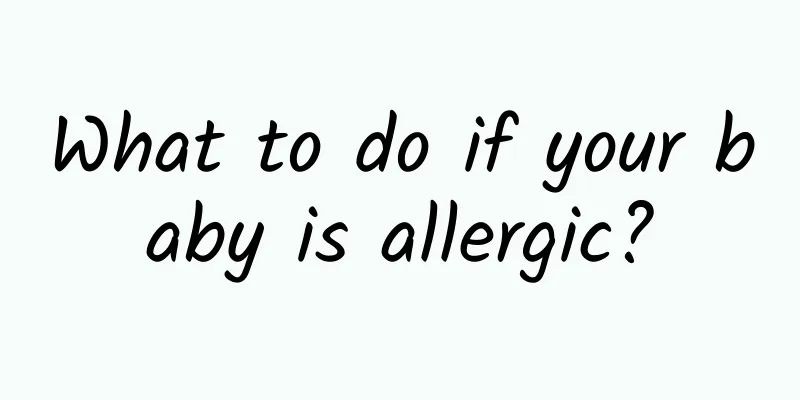Baby retches when sucking breast milk

|
The first mouthful of milk a baby eats after birth is very important, as it is the basis for recognizing milk. If he eats breast milk, he will not accept the pacifier. If he eats the pacifier since birth, he will not easily accept breast milk, so mothers must try their best to breastfeed. But why do some babies gag when they suck breast milk? This issue is quite complicated. Maybe it has something to do with the amount of breast milk, or maybe it has something to do with the baby's sucking ability. Many parents do not understand how to successfully breastfeed, and feed their newborn babies formula with bottles at an early stage. Soon, the baby fell in love with the ease of sucking the pacifier and became familiar with the technique of sucking the pacifier. He had neither interest in sucking his mother's nipple nor did he know how to suck it. Seeing the baby crying and refusing to suck the mother's breast, the family members feel distressed and anxious, and they don't know how to correct nipple confusion. As a result, the baby is fed more and more milk powder and less and less breast milk, and slowly there is no more breast milk. The reason why it is called "confusion" is that the actions and techniques of sucking breast milk and sucking a bottle are different. After the baby gets used to the sucking way of the bottle, technical confusion will arise when sucking breast milk. When sucking on the pacifier, as long as you suck lightly with your mouth, the milk in the bottle will flow out due to the negative pressure in your mouth. Sucking breast milk requires the baby to use his tongue and jaw to squeeze the areola. . Many mothers have no choice but to continue bottle-feeding simply because they do not know the correct method to correct nipple confusion. The wrong method and the despair of no progress drag themselves and their families down. Therefore, do not make bottle-feeding or breastfeeding a temporary stopgap measure in extraordinary circumstances a regular feeding method. Mothers cannot be short-sighted and must look at the long term. Tips for Correcting Nipple Confusion The younger your baby is and the shorter the time he or she has been using a bottle, the easier it will be to correct nipple confusion. The trick to correct nipple confusion is not that mysterious. It is to stop using bottles and use a spoon to feed the baby until the baby accepts the mother's nipple again, or use "finger feeding" or any other feeding method other than bottles that the baby can accept. The biggest reason why babies with nipple confusion refuse their mother's nipple is that they feel that feeding this way is not as fast or easy as feeding from a bottle. Therefore, mothers can stimulate the milk flow before breastfeeding so that the baby can drink big mouthfuls of breast milk as soon as he touches the nipple. The specific method to stimulate milk letdown is to relax, think about the cute look of your baby while feeding, gently pinch the nipple with clean fingers, rotate it left and right, and touch the front end of the nipple from time to time. When your breasts feel itchy, become hard, and your nipples are moist, and milk spurts out when you pinch them gently, it means that milk letdown is coming. Pick up the baby and feed him quickly. The milk burst stimulation method is also helpful when using a breast pump to express milk. It’s best to try breastfeeding when your baby is not too hungry and in a good mood. This way the baby will be more patient and try for a while longer. Some parents think that if they starve their babies, the babies will eventually have to drink breast milk. This is wrong. A hungry baby will not have the patience to explore the technique of sucking on the mother's nipple. In addition, some babies do not completely refuse to suck their mother's nipples, and will use the correct latching and sucking posture to eat breast milk. They just don't understand that their mother's milk is secreted in waves, unlike the milk in the bottle that they can eat until it's gone. Therefore, when one milk flow is over and the next one has not yet arrived, the baby cannot suck and wait patiently, and will spit out the nipple and cry. At this time, the mother has two approaches to try. One is to pick up the baby and coax him/her, and then feed him/her when his/her mood improves. The second is to use a feeding aid to slowly release milk between two milk flows, "retaining" the baby to continue sucking in order to stimulate the next milk flow. So, the trick to correct nipple confusion is to stop using bottles immediately and decisively, but don't starve your baby. Try breastfeeding when your baby is not hungry, and feeding with a spoon or finger, or using a feeding aid to assist breastfeeding when your baby is hungry. Finger feeding The two main uses of finger feeding are: 1. Feeding newborn babies who are not yet able to drink breast milk directly; 2. Helping babies who reject their mother's nipples to accept their mother's nipples again. Finger feeding is more like breastfeeding than bottle feeding. When finger feeding, your baby's tongue is pointed down and forward over the gums, with the mouth open wide and the jaw pointed forward. In addition, the movements of the tongue and jaw are very similar to those of a baby sucking on the breast. Finger feeding tips: 1. Wash your hands. It is best to keep the finger nails short. 2. Assume a position that is comfortable for both you and your baby. For example, support your baby's head with one hand behind his shoulders and neck while he sits halfway up your lap, facing you. Whatever is comfortable for both you and your baby is fine, as long as your finger can fit flat in your baby's mouth. 3. You need a breastfeeding aid, which includes a feeding tube (you can buy an infusion hose at the pharmacy, the thinnest one at the bottom), a bottle, and the feeding tube extends into the liquid through the nipple opening. 4. Place the tube on the inside of your index finger (or other finger), with the fingertip facing up, and the tube should not protrude beyond the fingertip. Hold the hose down with your thumb. You can also stick the tube on your finger. 5. Use the finger with the tube to gently touch the baby's lips until the baby's mouth opens wide enough to fit your finger. If your baby is very sleepy but needs to be fed, you can slowly put your finger into his mouth. If necessary, turn your baby's lower lip outward. Generally speaking, babies will start sucking even if they are asleep, and they will usually wake up after swallowing the liquid. 6. Put your finger and the tube into your mouth together, so that the soft part of your finger is still on top. Try to keep your fingers as straight as possible so that your baby's tongue lies flat and forward. Usually babies will start sucking their fingers and suck them very deep. Babies don't usually gag because of a finger being pushed very deep inside unless they are already full or very used to the bottle. 7. Make sure your baby's lower lip is turned outward. 8. If the baby drinks it, this method works. If the feed is slow you can raise the bottle above your baby's head, but this shouldn't usually be necessary. Try to flatten your baby's tongue by straightening your finger. Do not bend your fingers upward. 9. Mothers should remember that the purpose of finger feeding is to train the baby to suck milk correctly, not to feed the baby, so there is no need to worry about the slow speed of milk sucking. Start by finger feeding for a few minutes, then once your baby is less hungry and more settled, try having him/her on the breast. If you still find it difficult, don't get discouraged. Try finger feeding again, and try the nipple later or next time. This trick usually works. However, for babies who have nipple confusion for a long time and severely reject their mother's nipple, they may sometimes need finger feeding for a few days, a week or even longer. About lactation aids Using a feeding aid is better than using an empty syringe, cup feeding, finger feeding or any other method because the baby is still sucking directly from the mother's breast. Babies can learn to suck milk from breastfeeding, and mothers can learn to feed milk from breastfeeding. Mother and son learn by doing together. Second, the mother's breasts are stimulated by sucking, and milk secretion increases, achieving the purpose of increasing milk production. Third, the baby's sucking needs are also met at the same time, which is the baby's earliest spiritual life. Fourth, mother and baby snuggle up to each other and work together. Such an experience is absolutely beneficial to increasing intimacy and trust between mother and child and cultivating mutual sensitivity between mother and child. What is a lactation aid? A lactation aid consists of a container for the supplement, usually a feeding bottle with an enlarged nipple, and a thin tube extending from the container. Ready-made lactation aids are available for purchase at a cost roughly equal to the price of two weeks' supply of formula. How to use a lactation aid 1. The baby should be on the breast first, and at the appropriate time, when the baby just starts to show signs of impatient sucking, put the tube in the baby's mouth. The more correctly your baby latches on, the easier it will be for him to get your breast milk and use a breast pump, and the sooner you can use a breast pump. Gently open the breast to see the corner of the baby's mouth, hold the tube with your index finger and thumb, put it into the corner of the baby's mouth, and insert it straight into the baby's mouth. At the same time, the tube should be slightly upwards, towards the upper palate. When the supplemental fluid can quickly flow into the tube, it means the tube is in the correct position. It is usually necessary to fill the tube with supplemental fluid before placing it in your baby's mouth. 2. Alternatively, place the tube on the mother's breast nipple first and let the baby directly latch on to the breast and the tube at the same time. Also, make sure your baby's latch is correct. 3. The tube can be attached to the mother's breast. Although this is not necessary and does not necessarily help, some mothers find it more convenient. 4. The tube needs to protrude beyond the nipple and function properly as long as it extends beyond the baby's gums. It seems to work better if the tube is placed at the corner of the baby's mouth and straight over the baby's tongue into the mouth. (Slightly toward the top of the baby's mouth). Some babies try to push the tube out with their tongues, and it sometimes helps if the mother holds the tube with her fingers. 5. The bottle containing supplements should be higher than the height of the baby's head. If the bottle of a lactation aid must be held above your baby's head in order to be used, something is wrong. You should only raise the bottle if your doctor or lactation specialist specifically advises you to do so. 6. It is best to supplement in small amounts and multiple times. Eight feedings a day with 30 ml each is better than two 120 ml feedings a day. 7. Don't break off the end of the tube; it works better as it is. 8. It should take about an hour to feed your baby 30 ml of milk using a lactation aid. If it doesn't take that long, the tube is not in place or the baby is not latching well. If the booster is functioning properly, your baby should only need 15-20 minutes or less to finish 30 ml of the supplement. 9. A more convenient secret: wear a shirt with pockets and put the bottle in the pocket. How to clean a lactation aid 1. Do not boil the tubes of the auxiliary device. The tubes cannot be boiled. 2. After using the equipment, clean the bottles and nipples as usual. Do not boil the tubes. The tubes should be emptied after use, then rinsed with hot water (using the tube to draw hot water from the cup) and hung to dry. The tube may become dry and hard and unsuitable for use after about a week. When to stop using a lactation aid For the purpose of correcting nipple confusion, the breastfeeding aid can be retired after the baby is willing to suck breast milk for a long time. Of course, the premise is that the baby can urinate at least 6-8 times a day without taking supplements and only taking breast milk. This means your baby is getting enough milk. If your baby's urine output does not reach this standard after the aid is removed, it means you need to use the aid for a few more days. |
<<: The impact of parents' drug abuse on their children
>>: How to increase breast milk
Recommend
What to do if herpes appears on the body? Traditional Chinese medicine has folk remedies for treatment
I believe that many people in life have experienc...
How to calm down an anxious mind
Today's society is developing at a fast pace,...
Taboos of Polygonum multiflorum soup
Nowadays, more and more people know how to use di...
What causes chickenpox scars?
Not only children but adults can also get chicken...
I took gastrointestinal anti-inflammatory drugs and had heart pain
Many people do not pay attention to their diet an...
Can I eat chrysanthemum if I have internal heat?
The term "virtual fire" is only found i...
What should I do if I have poor stomach digestion?
Nowadays, we don’t pay much attention to our gast...
Traditional Chinese medicine breast enhancement, traditional Chinese medicine recommends several breast enhancement methods
Firm and plump breasts are the goal pursued by ma...
Is Danshen hot or cool?
Salvia miltiorrhiza is a tonic with high nutritio...
Is acne peeling a good thing?
Acne is a common skin disease. When acne graduall...
What is the pain around the kidney?
Sometimes in life, people may inadvertently feel ...
What should I do if my second child suffers from postpartum anxiety?
With the implementation of the comprehensive two-...
The role of safflower oil
Safflower oil is probably the most common health ...
Tooth root itching solution
After getting angry, many people always feel that...
What to do if your toenails are black?
The phenomenon of blackened nails is very common ...









